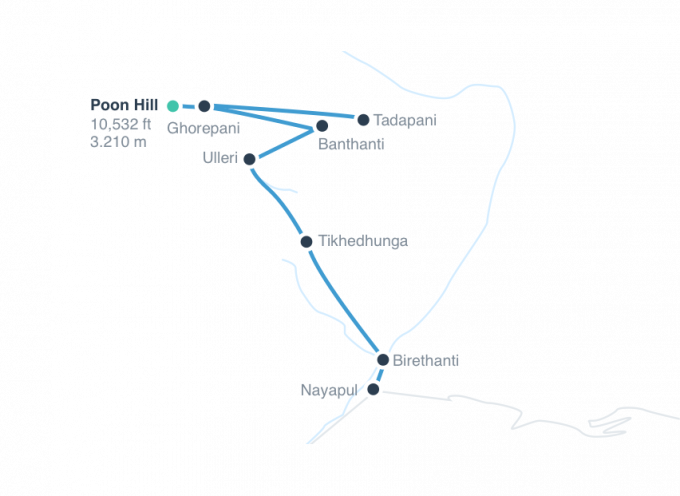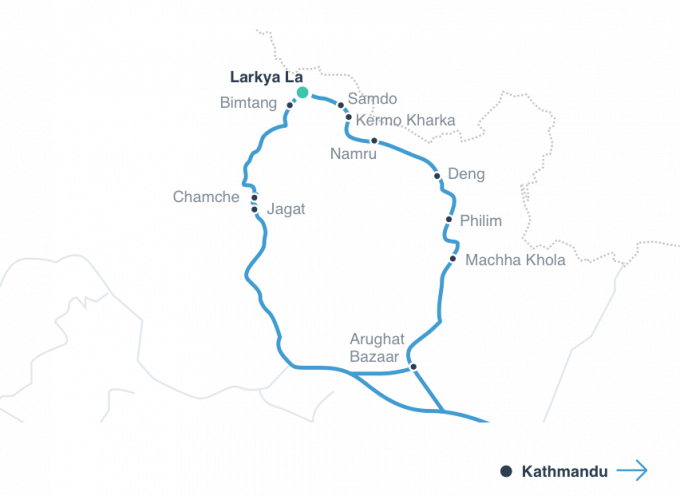
The Nepalese Himalayas
The Nepalese Himalayas, home to many of the Earth's highest peaks, is considered to be the holy grail for trekking enthusiasts. Once reserved solely for intrepid explorers, travellers can now safely venture along the rugged trails to the likes of Everest Base Camp, Poon Hill, or cover the Annapurna Circuit - where words fail to describe just how beautiful it really is.
Seasonality & Climbing Requirements
How do I prepare for the Nepalese Himalayas?
For almost all routes within the Nepalese Himalayas, there is a risk of altitude sickness, so travellers should be prepared with the relevant medication and by selecting a longer route where possible to ensure enough time is allocated for acclimatisation. Learn more.
When should I trek the Nepalese Himalayas?
The months of September to December are considered the best months to go trekking in the Nepalese Himalayas as the weather will be mostly pleasant with good visibility. Some routes you can trek year-round, however, this depends on your experience with hiking in extreme weather. Learn more.
What permits do I need?
For all treks in Nepal, you will need a TIMS (Trekkers' Information Management Systems) card. In addition to a TIMS card, you will need a permit for each route, however, the availability and cost will vary. Learn more.
Do I need a guide to trek?
If you are an experienced trekker, you will be able to travel by yourself in the Nepalese Himalayas without a guide. Just remember, a good guide is there to ensure you arrive safely, but also to share insights into the local culture and history. Learn more.
How do I get to the Nepalese Himalayas?
Regardless of what route you choose, all international flights only arrive in Kathmandu, the capital of Nepal. Upon arrival in Kathmandu, you have the option to organise internal flights, by helicopter or by road to reach your starting point. Learn more.
What should I pack and what equipment do I need?
Some tours will stay at teahouse accommodation and others will stay in tents along the way, so be sure to check with your tour operator with what you might need as this may vary greatly between routes and tours. Learn more.
Best Nepalese Himalayas Treks & Routes

Poon Hill
The Ghorepani Poon Hill trek is considered to be one of the best short treks in the world and is famed for providing the best vistas of Annapurna and Dhaulagiri. The views are nothing short of striking, and there are plenty of opportunities for local cultural experiences along the way.Read more
Distance: 51 kilometres
Average duration: The Ghorepani Poon Hill trek can be completed in 4-5 days.
Average difficulty/success rate: Anyone with a moderate level of fitness should able to comfortably complete this trek. Due to the high altitude, travellers should be aware there is a risk of altitude sickness.
Annapurna Base Camp
Offering a close-up view of the Annapurna range and jaw-dropping peaks, it’s no surprise that this route is one of the most popular treks in Nepal. Highlights include plenty of fauna and flora sightings and the chance to hike through an area that is completely untouched by road construction.Read more
Distance: 110 kilometres
Average duration: Also known as the Annapurna Sanctuary trek or ABC trek, this journey can be completed in 7-10 days depending on what route you select.
Average difficulty/success rate: The Annapurna Base Camp trek is rated at a moderate difficulty. You will be trekking for 5-8 hours every day, and thus this route is best suited to trekkers with a moderate level of fitness. Due to the trail length, altitude sickness is not as prevalent, as there are good opportunities for acclimatization. However, travellers should still be aware of the risk.
Everest Base Camp
For mountain lovers, the Everest Base Camp trek is where dreams are fulfilled and new challenges will be overcome by experienced and beginner trekkers. At every corner, you’ll be met with glacial moraines, vibrant forests, or high-altitude landscapes and plenty of spectacular photo opportunities.Read more
Distance: 130 kilometres
Average duration: The Everest Base Camp trek typically takes around 12-16 days depending on what tour you choose.
Average difficulty/success rate: This trek is moderately challenging as it will involve high elevation, and even the start of the trek will begin at over 2,600m and the daily elevation gain will be 400-800m. Anyone with a moderate level of fitness should be able to complete this journey.
Manaslu Circuit
Considered by many to be a truly remote adventure, the Manaslu Circuit appeals to travellers as there is teahouse accommodation available at every stage. Then trek itself covers subtropical jungle terrain before reaching the Himalayan foothills and high-altitude crossings above 5,100m.Read more
Distance: 177 kilometres
Average duration: 13-17 days depending on what tour or operator you choose to complete the hike with.
Average difficulty/success rate: In order to hike this route, you will need to be relatively fit as you will be hiking for 6-8 hours per day on uneven terrain at high altitudes. Altitude sickness is definitely a risk on this route, and trekkers should be aware of this.
Makalu Base Camp
Terraced farmlands, rhododendron forests, and soaring peaks are just a few of the memorable sights you will encounter during this unforgettable journey. For trekkers who relish in the opportunity for a challenge, the lure of the Makalu Base Camp expedition is difficult to ignore.Read more
Average duration: The trek can be completed in 18-20 days, but the average length is 22 days.
Average difficulty/success rate: This trek is challenging and should only be attempted by trekkers who have experience with high altitudes.
Upper Mustang Trek
The Upper Mustang Trek is a sensational journey that offers a chance for travellers to visit Upper Mustang, The Lost Tibetan Kingdom that was previously prohibited for foreigners to visit until 1991. The route is characterised by barren landscapes, moraine valleys, deep canyons, and high-altitude terrain.Read more
Average duration: The average duration is 10-12 days, but this may be less or more depending on which tour you choose.
Average difficulty/success rate: Previous trekking experience is highly recommended, as the days will feature 6-8 hours hiking with daily ascents of 900m to 1,000m, perhaps with the odd day ascending around 1,100m to 1,200m. Depending on the route, you may be trekking at an altitude of over 3,500 m. Altitude sickness is a concern on this route, and trekkers should prepare to reduce any negative side effects.
Langtang Valley
A short, but mighty trek, the Langtang Valley trek is ideal for beginner trekkers and is easily accessible from Kathmandu. A major highlight, aside from the panoramic views, is that your travel choice will help to support the communities and people in the area to rebuild after the 2015 earthquake.Read more
Distance: 120 kilometres
Average duration: This trek can be completed in 7-11 days.
Average difficulty/success rate: This trek is ideal for beginners, as it is considered a moderate trek. It will be challenging, however, it does not require any technical skills. Travellers should be aware that altitude sickness is a risk and preparation is necessary to help reduce any symptoms.
Three Passes Trek
Offering scenic mountain views and local experiences, the Three Passes trek is considered to be one of the most rewarding routes. As the name suggests, you will cross three challenging 5,000m passes, Cho La, Kongma La and Renjo La but without the same crowds that other routes attract.Read more
Distance: 166 kilometres
Average duration: The average completion is 18-20 days.
Average difficulty/success rate: This is a challenging and tough trek due to the high altitudes and there is a high risk of acute mountain sickness. For this reason, it is suggested that only experienced trekkers make the journey to this specific region.
Nepalese Himalayas General Facts
The Location
The Nepalese Himalayas are located in the east-central part of the Himalayan mountain range, and cover almost 75% of Nepal.
Coordinates
The coordinates of Mount Everest are 27.9881° N, 86.9250° E.
Elevation
The Nepalese Himalayas are home to some of the highest peaks in the world, including Mount Everest, which sits at 8,848 metres above sea level.
Mountain Range
The Nepalese Himalayas belong to the Himalayan mountain range and are over 2,400 kilometres long. The highest peak is Mount Everest (8,848 m).
Length
Among the Nepalese Himalayas, there are both short routes and long routes. Depending on what route or tour you choose, you can complete a trek such as Poon Hill in 4-5 days, whereas the Everest Base Camp can be completed in 9-15 days.
Arrival
In order to reach the Nepalese Himalayas, travellers can fly into Kathmandu – the only international airport in Nepal – and make your way to Lukla, which is a small town that is often used as a starting point for trekking in the area.
Nepalese Himalayas Weather
| JAN | FEB | MAR | APR | MAY | JUN | JUL | AUG | SEP | OCT | NOV | DEC | |
|---|---|---|---|---|---|---|---|---|---|---|---|---|
| Average °C | -8 | -8 | -5 | -1 | 4 | 8 | 9 | 9 | 7 | 2 | -2 | -5 |
| Average °F | 17 | 17 | 23 | 30 | 39 | 46 | 48 | 48 | 44 | 35 | 28 | 23 |
| High °C | -2 | -3 | 1 | 4 | 9 | 12 | 12 | 11 | 10 | 6 | 2 | 0 |
| High °F | 28 | 26 | 33 | 39 | 48 | 53 | 53 | 51 | 50 | 42 | 35 | 32 |
| Low °C | -22 | -23 | -18 | -12 | -8 | -6 | -3 | -4 | -6 | -10 | -14 | -17 |
| Low °F | -7 | -9 | 0 | 10 | 17 | 21 | 26 | 24 | 21 | 14 | 6 | 1 |





















